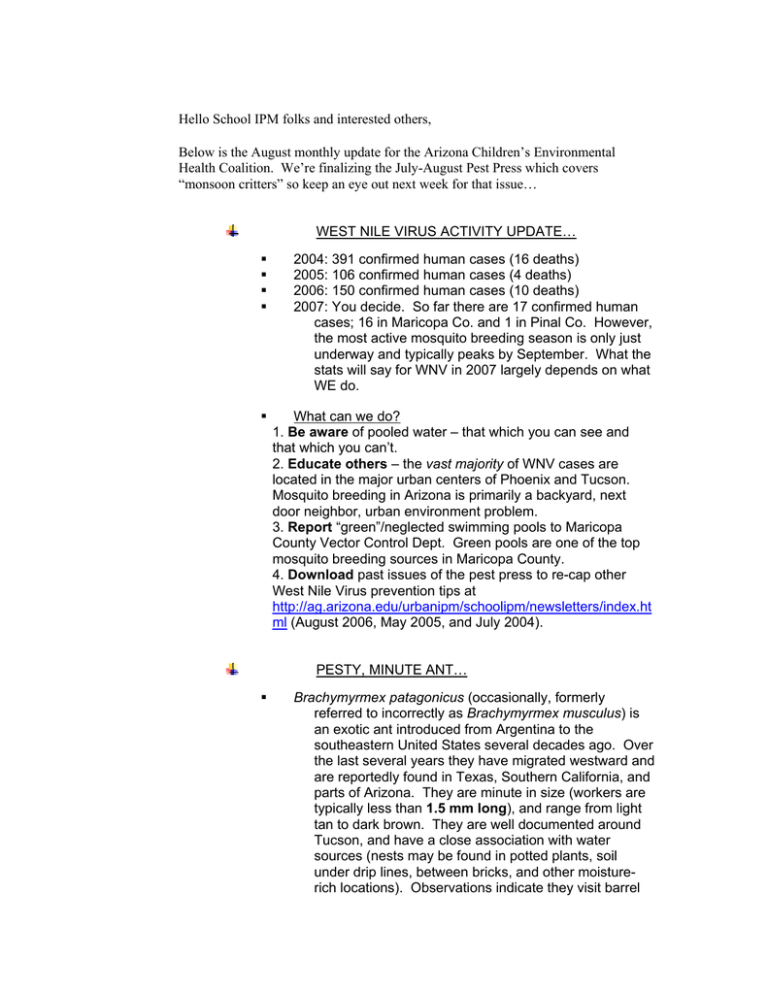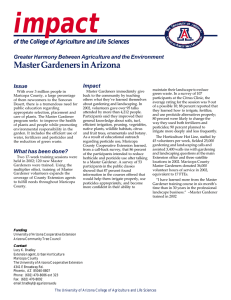Hello School IPM folks and interested others,
advertisement

Hello School IPM folks and interested others, Below is the August monthly update for the Arizona Children’s Environmental Health Coalition. We’re finalizing the July-August Pest Press which covers “monsoon critters” so keep an eye out next week for that issue… WEST NILE VIRUS ACTIVITY UPDATE… 2004: 391 confirmed human cases (16 deaths) 2005: 106 confirmed human cases (4 deaths) 2006: 150 confirmed human cases (10 deaths) 2007: You decide. So far there are 17 confirmed human cases; 16 in Maricopa Co. and 1 in Pinal Co. However, the most active mosquito breeding season is only just underway and typically peaks by September. What the stats will say for WNV in 2007 largely depends on what WE do. What can we do? 1. Be aware of pooled water – that which you can see and that which you can’t. 2. Educate others – the vast majority of WNV cases are located in the major urban centers of Phoenix and Tucson. Mosquito breeding in Arizona is primarily a backyard, next door neighbor, urban environment problem. 3. Report “green”/neglected swimming pools to Maricopa County Vector Control Dept. Green pools are one of the top mosquito breeding sources in Maricopa County. 4. Download past issues of the pest press to re-cap other West Nile Virus prevention tips at http://ag.arizona.edu/urbanipm/schoolipm/newsletters/index.ht ml (August 2006, May 2005, and July 2004). PESTY, MINUTE ANT… Brachymyrmex patagonicus (occasionally, formerly referred to incorrectly as Brachymyrmex musculus) is an exotic ant introduced from Argentina to the southeastern United States several decades ago. Over the last several years they have migrated westward and are reportedly found in Texas, Southern California, and parts of Arizona. They are minute in size (workers are typically less than 1.5 mm long), and range from light tan to dark brown. They are well documented around Tucson, and have a close association with water sources (nests may be found in potted plants, soil under drip lines, between bricks, and other moisturerich locations). Observations indicate they visit barrel cacti in urban environments, but not yet documented in rural desert habitat. These tiny ants are occasional invaders of homes and other urban structures. Please respond to this message for ID information, pictures, and links on this ant. (Thanks to Carl Olson, Michelle Lanan and Alex Wild, University of Arizona, for this information!) If you have or suspect you have Brachymyrmex patagonicus, please contact Dawn or Jennifer at 520-568-2273. POTENTIAL LINK BETWEEN PESTICIDES AND AUTISM… A brief summary of the study: SACRAMENTO Researchers for the California Department of Public Health say two pesticides used on cotton and some other crops may be linked to autism. Researchers studied women who lived near fields that had been sprayed with the pesticides endosulfan and dicofol early on in their pregnancy. Those women were six times more likely to have autistic children than women who did not live near the fields. The study used data from 1996 to 1998. Since then, many farmers have stopped using the pesticides. And pregnant women are much less likely to be exposed to them. -Associated Press The complete study, published in the July issue of Environmental Health Perspectives, is attached here as a .pdf file. COLONY CALLAPSE DISORDER RESEARCH TO COME… Several folks have expressed interest in following the colony collapse disorder (CCD) phenomenon, which has affected honeybee populations around the world since fall 2006. Florida’s extension describes the disorder: “Beekeepers report that in colonies with CCD, dead bees are not found in the hive or on the ground outside of the colonies. The adult bees simply disappear. The final symptom is that small hive beetles, wax moths, and other nearby honey bees ignore the empty hive even though the hive contains foodstuffs on which they ordinarily feed.” In June, the U.S. Dept. of Agriculture (USDA) announced a research action plan for CCD. The plan will guide research looking into four possible causes of CCD: 1. 2. 3. 4. new or reemerging pathogens new bee pests or parasites environmental and/or nutritional stress pesticides The USDA Under Secretary for Research, Education and Economics Gale Buchanan said, “There were enough honeybees to provide pollination for US agriculture this year, but beekeepers could face a serious problem next year and beyond.” NEED HELP WITH PIGEON CONTROL?... OvoControl interferes with the hatchability of avian eggs. The active ingredient, nicarbazin, is registered both by the FDA and EPA. The compound has been developed and registered for hatch control in pest birds such as Canada geese and feral pigeons. Further EPA registration applications in other avian species are pending. 9 The product does not kill or injure pigeons. 9 The product prevents eggs from hatching so reduces the population over time, without the need to trap or destroy nests. 9 This is a humane management option that is a reduced-risk product. It has been confirmed to be very safe around humans, including children. 9 Effect on non-target bird species is minimal when applied according to product label. 9 University of Arizona Urban IPM staff do not have any direct experience to advise on the efficacy or if any of our native birds will feed on the bait. Bill Lawrence of Mesa Public Schools used OvoControl and observed only pigeons feeding on the bait. If anyone chooses to try the product we would be grateful for any feed backpositive or negative. See www.hatchcontrol.com for more information. Jennifer L. Snyder Research Specialist & School IPM Program Coordinator University of Arizona Maricopa Agricultural Center 37860 W. Smith-Enke Rd. Maricopa, AZ 85239 ph: 520.381.2266 fax: 520.568.2556 jsnyder@ag.arizona.edu http://ag.arizona.edu/urbanipm/



